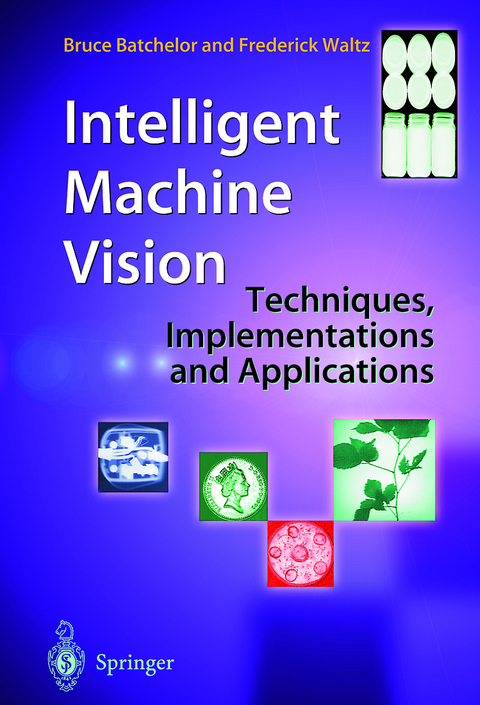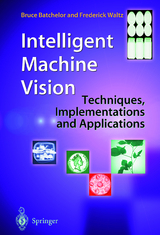Intelligent Machine Vision
Springer Berlin (Verlag)
978-3-540-76224-9 (ISBN)
Drawing on half a century of combined experience, the authors describe state of the art and the latest developments in the field, including:
- fundamentals of 'intelligent' image processing, specifically intended for Machine Vision systems;
- algorithm optimization;
- implementation in high-speed electronic digital hardware;
- implementation in an integrated high-level software environment;
- applications for industrial product quality and process control.
There are hundreds of illustrations in the book, most of them created using the author's 'PIP' software - a sophisticated intelligent image processing package.
A demonstration version of this software, as well as numerous examples from the book, are available at the authors' Web site: http://bruce.cs.cf.ac.uk/bruce/index.html
1 Machine vision for industrial applications.- 1.1 Natural and artificial vision.- 1.2 Artificial vision.- 1.3 Machine Vision is not Computer Vision.- 1.4 Four case studies.- 1.5 Machine Vision is engineering, not science.- 1.6 Structure, design, and use of machine vision systems.- 1.7 Other design tools.- 1.8 Outline of this book.- 2 Basic machine vision techniques.- 2.1 Representations of images.- 2.2 Elementary image-processing functions.- 2.3 Binary images.- 2.4 Binary mathematical morphology.- 2.5 Grey-scale morphology.- 2.6 Global image transforms.- 2.7 Texture analysis.- 2.8 Further remarks.- 3 Algorithms, approximations, and heuristics.- 3.1 Introduction.- 3.2 Changing image representation.- 3.3 Redefining algorithms.- 3.4 Approximate and heuristic methods.- 3.5 Additional remarks.- 4 Systems engineering.- 4.1 Interactive and target vision systems.- 4.2 Interactive vision systems, general principles.- 4.3 Prolog image processing (PIP).- 4.4 Advanced aspects of PIP.- 4.5 Windows image processing (WIP).- 4.6 Web-based image processing (CIP).- 4.7 Target (factory floor) vision systems.- 4.8 Concluding remarks.- 5 Algorithms and architectures for fast execution.- 5.1 Classification of operations.- 5.2 Implementation of monadic pixel-by-pixel operations.- 5.3 Implementation of dyadic pixel-by-pixel operations.- 5.4 Implementation of monadic neighborhood operations.- 5.5 Implementation of monadic global operations.- 5.6 SKIPSM - a powerful implementation paradigm.- 5.7 Image-processing architectures.- 5.8 Systems with random access to image memory.- 5.10 Systems for continuous web-based processing.- 6 Adding intelligence.- 6.1 Preliminary remarks.- 6.2 Implementing image-processing operators.- 6.3 Very Simple Prologs+ (VSP).- 6.4 PIP.- 6.5 WIP.- 6.6 Concludingremarks.- 7 Vision systems on the Internet.- 7.1 Stand-alone and networked systems.- 7.2 Java.- 7.4 CIP.- 7.5 Remarks.- 8 Visual programming for machine vision.- 8.1 Design outline.- 8.2 Data types.- 8.3 Nonlinear feedback blocks.- 8.4 Visual programming environment.- 8.5 Image viewer and tools.- 8.6 Sample problems.- 8.7 Summary.- 9 Application case studies.- 9.1 Preliminary remarks.- 9.2 Taking a broad view.- 9.3 Cracks in ferrous components.- 9.4 Aerosol spray cone.- 9.5 Glass vial.- 9.6 Coin.- 9.7 Metal grid.- 9.8 Toroidal metal component.- 9.9 Mains power plug (X-ray).- 9.10 Conclusions.- 10 Final remarks.- 10.1 Interactive prototyping systems.- 10.2 Target vision systems.- 10.3 Design tools.- 10.4 Networked systems.- 10.5 Systems integration.- 10.6 Algorithms and heuristics.- 10.7 Concluding comments.- Appendix A Programmable color filter.- Representation of color.- Color triangle.- Mapping RGB to HSI.- Programmable color filter (PCF).- Software.- Appendix B A brief introduction to Prolog.- Prolog is different.- Declarative programming.- Facts.- Simple queries.- Rules.- Queries involving rules.- Backtracking and instantiation.- Recursion.- Lists.- Other features.- Further reading.- Appendix C PIP commands and their implementation.- References.- Further reading.
| Erscheint lt. Verlag | 7.8.2001 |
|---|---|
| Zusatzinfo | XXIV, 422 p. |
| Verlagsort | London |
| Sprache | englisch |
| Maße | 155 x 235 mm |
| Gewicht | 974 g |
| Themenwelt | Informatik ► Grafik / Design ► Digitale Bildverarbeitung |
| Mathematik / Informatik ► Informatik ► Software Entwicklung | |
| Informatik ► Theorie / Studium ► Künstliche Intelligenz / Robotik | |
| Naturwissenschaften ► Physik / Astronomie ► Optik | |
| Schlagworte | Artificial Intelligence • Computergrafik • computer vision • Digitale Bildverarbeitung • Filter • Heuristics • Image Processing • Machine vision • Optimization • PROLOG • Tracking |
| ISBN-10 | 3-540-76224-8 / 3540762248 |
| ISBN-13 | 978-3-540-76224-9 / 9783540762249 |
| Zustand | Neuware |
| Haben Sie eine Frage zum Produkt? |
aus dem Bereich




